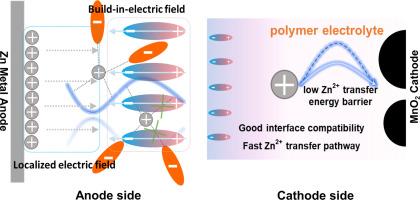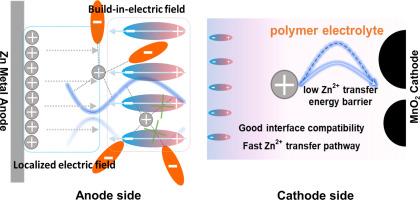Piezoelectric gradient electrolytes for environmentally adaptive and stable zinc batteries
IF 20.2
1区 材料科学
Q1 CHEMISTRY, PHYSICAL
引用次数: 0
Abstract
Solid polymer electrolyte-based zinc batteries are promising candidates for next-generation electrochemical energy storage due to their cost-effectiveness, enhanced safety and high theoretical energy density. However, their practical deployment is severely hindered by sluggish Zn2+ ion mobility, poor interfacial compatibility and uneven electric field distribution. To address the persistent challenges, this work presents a novel asymmetric piezoelectric electrolyte, engineered by the strategic vertical distribution of piezoelectric barium titanate (BTO) nanofillers within a polyvinylidene fluoride (PVDF)-based polymer matrix. This design introduces a built-in gradient electric field across the electrolyte thickness, leveraging the electromechanical properties of BTO to regulate ion transport and interfacial dynamics. On the Zn anode-facing side, the BTO-rich region with a high dielectric constant and enhanced local polarization, promotes zinc salt dissociation and generates a directional electric field that promotes uniform Zn2+ flux. This configuration effectively suppresses dendrite formation and mitigates localized charge accumulation. Conversely, the MnO2 cathode-facing side comprises a softer, polymer-rich phase with lower BTO content, ensuring better interfacial compliance and reduced contact resistance, which is crucial for facilitating efficient ion transport without inducing excessive polarization. As a result, the asymmetric architecture achieves an impressive ionic conductivity of 1.39 mS·cm-1 and a high Zn2+ transference number of 0.69 at room temperature, outperforming conventional SPEs. ZnǀǀZn symmetric cells exhibit outstanding cycle stability, sustaining operation for over 1500 h, while Zn||MnO2 full batteries demonstrate stable cycling over 1200 cycles. Notably, the battery performs reliably across a wide temperature range from -30 °C to 60 °C, demonstrating strong adaptability to harsh environments. This work provides a scalable and effective strategy for overcoming key limitations in Zn-based batteries by introducing a functionally asymmetric, piezoelectric electrolyte structure. This advancement paves the way for the development of safe, durable, and high-efficiency zinc-ion batteries.


环境适应稳定锌电池的压电梯度电解质
固体聚合物电解质锌电池具有成本效益高、安全性强、理论能量密度高等优点,是下一代电化学储能的理想选择。然而,由于Zn2+离子迁移缓慢、界面相容性差和电场分布不均匀,严重阻碍了它们的实际部署。为了解决持续存在的挑战,本研究提出了一种新型的不对称压电电解质,该电解质通过压电钛酸钡(BTO)纳米填料在聚偏氟乙烯(PVDF)基聚合物基体中的战略性垂直分布来设计。该设计在电解质厚度上引入了一个内置的梯度电场,利用BTO的机电特性来调节离子传输和界面动力学。在Zn阳极侧,具有高介电常数和增强的局部极化的bto富区促进锌盐解离,并产生一个定向电场,促进Zn2+通量均匀。这种结构有效地抑制了枝晶的形成,减轻了局部电荷的积累。相反,面向阴极的MnO2侧包含更柔软、富含聚合物的相,BTO含量较低,确保了更好的界面相容性和更低的接触电阻,这对于促进高效离子传输而不引起过度极化至关重要。结果表明,不对称结构的离子电导率为1.39 mS·cm-1,室温下Zn2+转移数为0.69,优于传统的spe。ZnǀǀZn对称电池表现出出色的循环稳定性,持续运行超过1500小时,而Zn||MnO2全电池表现出超过1200个循环的稳定循环。值得注意的是,该电池在-30°C至60°C的宽温度范围内性能可靠,对恶劣环境具有很强的适应性。这项工作通过引入功能不对称的压电电解质结构,为克服锌基电池的关键限制提供了一种可扩展和有效的策略。这一进展为开发安全、耐用、高效的锌离子电池铺平了道路。
本文章由计算机程序翻译,如有差异,请以英文原文为准。
求助全文
约1分钟内获得全文
求助全文
来源期刊

Energy Storage Materials
Materials Science-General Materials Science
CiteScore
33.00
自引率
5.90%
发文量
652
审稿时长
27 days
期刊介绍:
Energy Storage Materials is a global interdisciplinary journal dedicated to sharing scientific and technological advancements in materials and devices for advanced energy storage and related energy conversion, such as in metal-O2 batteries. The journal features comprehensive research articles, including full papers and short communications, as well as authoritative feature articles and reviews by leading experts in the field.
Energy Storage Materials covers a wide range of topics, including the synthesis, fabrication, structure, properties, performance, and technological applications of energy storage materials. Additionally, the journal explores strategies, policies, and developments in the field of energy storage materials and devices for sustainable energy.
Published papers are selected based on their scientific and technological significance, their ability to provide valuable new knowledge, and their relevance to the international research community.
 求助内容:
求助内容: 应助结果提醒方式:
应助结果提醒方式:


